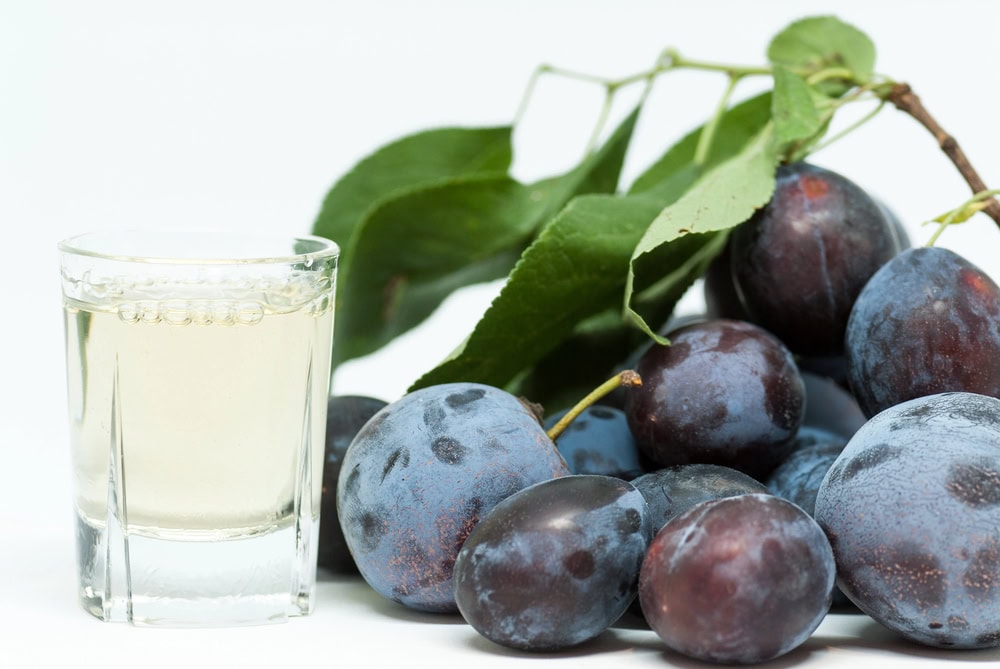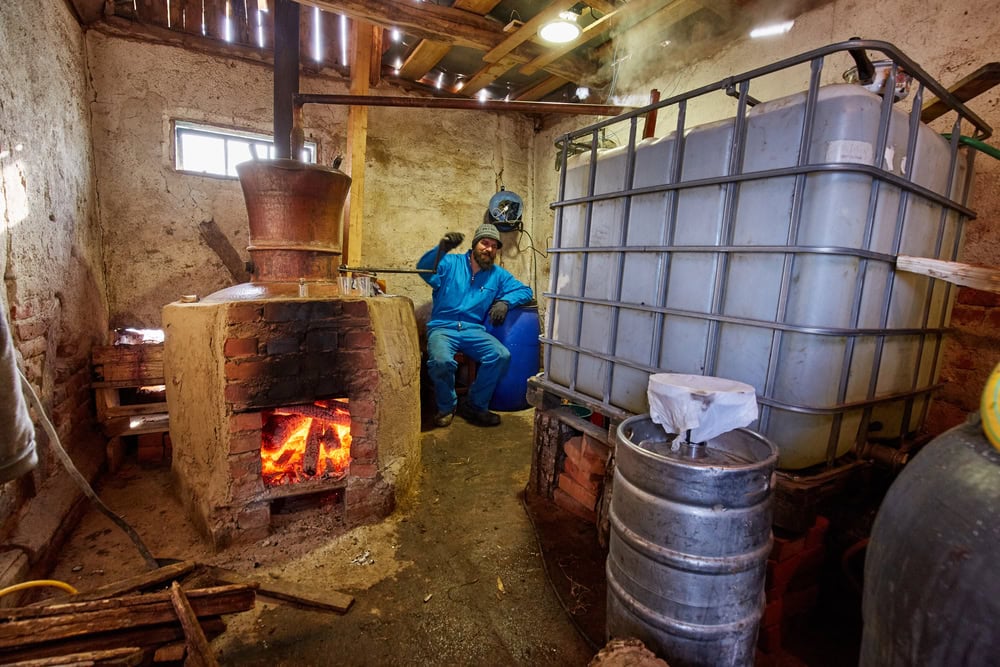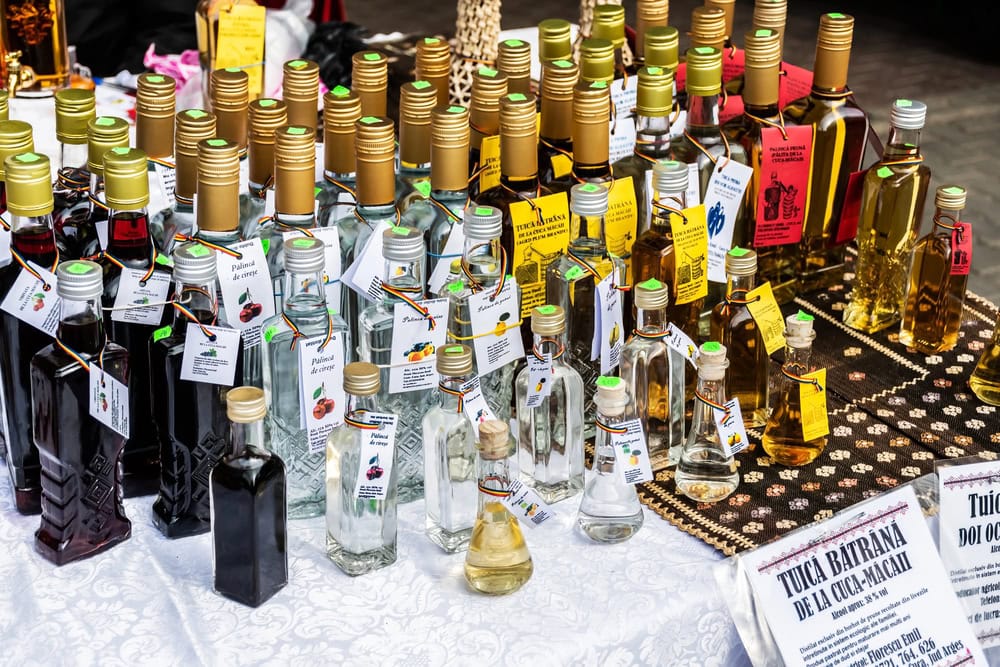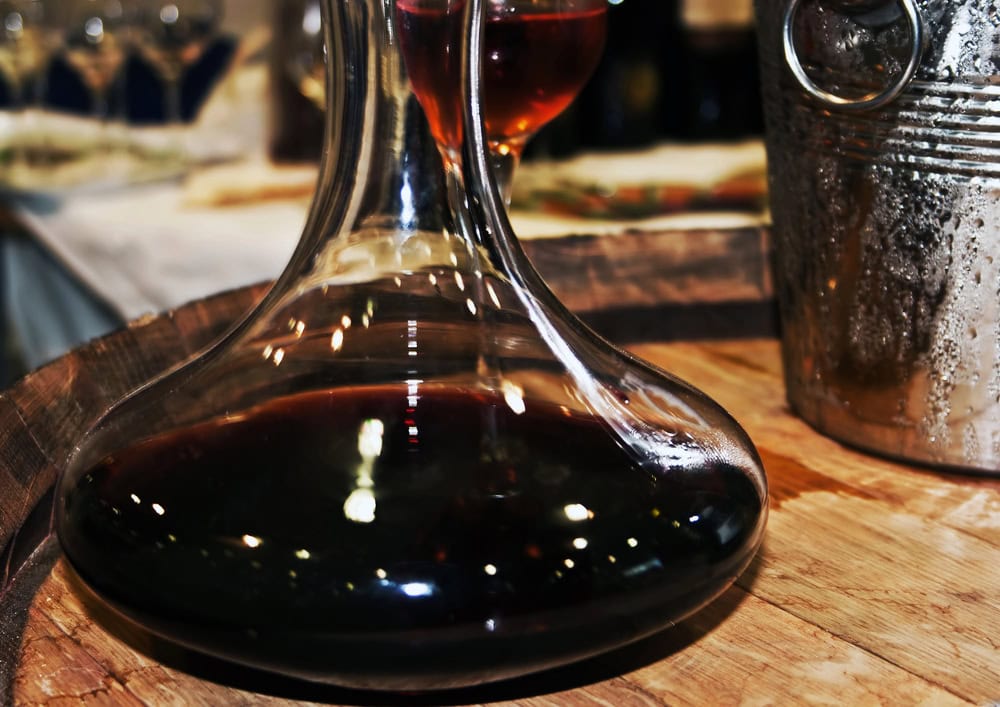As you explore the rich culinary landscape of Romania, you’ll inevitably encounter tuica, the country’s version of plum brandy. This traditional spirit is more than just a drink; it’s a gateway to understanding Romanian culture. When you taste tuica, you’re not just savoring a distilled spirit, you’re diving into a centuries-old story that echoes through the Carpathian Mountains.

Tuica is deeply intertwined with Romanian traditions and family gatherings. It’s anticipation of plums ripening under the frosty dawn, the pride of villagers offering their homemade brew, and the warmth of laughter shared during meals. Pairing tuica with traditional Romanian dishes is like a warm welcome from the Romanian countryside.
Whether you’re drawn to its rich history, artisanal craftsmanship, or simply its unique flavor, tuica offers a connection to the soul of Romania.
How Do You Pronounce Tuica?
Tuica is pronounced as “TSWEE-kah.”
The “t” sound is similar to the “ts” in “bits.” The accent on the “i” elongates the sound, so you emphasize the “ee” part a bit more.
What is Tuica?
Tuica, Romania’s national drink, is a traditional fruit brandy that incorporates Romanian culture and hospitality. Primarily made from the abundant plum found in the country, the spirit’s aroma is a captivating blend of fruity sweetness and a rich earth.
Tuica is deeply intertwined with Romanian traditions and celebrations. It’s often served at milestone events like weddings, baptisms, as well as at family gatherings. When offered a shot of tuica, it’s more than just a drink – it’s a gesture of welcome and inclusion, signifying that you’re part of the family. This spirit is an integral part of Romanian life, reflecting the important values of warmth and generosity.
For those new to tuica, it’s essential to approach it with respect. Unlike spirits meant for quick consumption, tuica is best savored slowly. By sipping it deliberately, much like Romanian wine, you allow its complex flavors to unfold as you honor the traditions that make tuica a memorable part of any Romanian encounter.
Traditionally, tuica is made by fermenting plums for six to eight weeks, followed by distillation using copper or brass stills heated over wood fires or charcoal. The process yields two main types: a stronger version, often distilled twice, and a lighter one. Some tuica is aged in oak barrels for up to ten years, giving it a rich, yellow hue and a sweet, fruity aroma. While plum-based tuica is the most common, other fruits can be used to create similar spirits, known as “rachiu” in Romanian culture
History of Tuica
The precise origins of tuica are not well-documented, but it’s believed that the tradition of fermenting and distilling fruits, particularly plums, has existed in Romania for over a thousand years. Archaeological findings, including ancient distillation equipment, suggest that spirit production has a long history in the Carpathian region.
References to tuica can be found in Romanian historical texts and documents from the medieval period. It was during these times that tuica began to establish its significance, moving from a homemade spirit to one commercially traded.
The industrialization of the 19th and 20th centuries introduced more refined distillation techniques and an increase in small-scale distilleries. Despite technological advancements, many producers continued to use traditional methods, appreciating the authenticity and distinct flavor profiles that small batches provided. Today, while the essence of tuica remains traditional, there are ongoing efforts to standardize and regulate its production for commercial sales.
How is Tuica Made?
The production of tuica involves a meticulous process that begins with the selection of plums. Typically, the preparation starts in early October and continues until early December, ensuring that the process is completed before Christmas. Plums are picked from orchards, often by gently shaking them from the trees into baskets or nets. This ensures that that only the ripest fruit is collected, and avoids spontaneous fermentation caused by grass piercing the plum skins.

Fermentation occurs in large wooden or stainless steel containers for about six to eight weeks. No sugar is added during this process. Once fermentation is complete, the plum mash undergoes distillation, traditionally using a brass or copper still heated by wood fires or charcoal. The distillation process captures the alcohol vapors, resulting in a clear, warming plum spirit.
The distillation process typically yields two types of tuica: a stronger version, often distilled twice, with an alcohol content of about 55-60%, and a milder version with an alcohol content between 20-30%. After distillation, tuica may be aged in oak barrels for several months to ten years, which can impart a yellow color and a fruity aroma, or it may be consumed immediately.
Palinca or Tuica
In the spirit-splashed tapestry of Romania, two traditional drinks stand out: tuica and palinca. While both are fruit brandies, they differ significantly in terms of production, flavor, and cultural context.
Tuica is a traditional Romanian spirit made exclusively from plums, often enjoyed as an aperitif or digestif. Palinca is a more generic term for fruit brandy, which can be made from a variety of fruits such as apricots, pears, and apples. However, when referring specifically to plum brandy, palinca de prune is used. Palinca is often double-distilled, resulting in a higher alcohol content compared to tuica. This process gives palinca a stronger and more complex character, making it a popular choice for festive occasions.
While tuica is primarily associated with Romanian culture, palinca is enjoyed across several neighboring countries, including Hungary and the Czech Republic.
The cultural significance of these spirits also varies. Tuica is often served at home gatherings and traditional events, such as weddings and holidays, where it is valued for its authentic taste and cultural heritage. In contrast, palinca is more commonly associated with formal celebrations and is appreciated for its intense flavors and warming effects. Despite these differences, both tuica and palinca are integral to Romanian traditions and are appreciated for their individual characteristics.
Where to Find the Best Tuica
Transylvania, a realm of enigmatic landscapes and tales as old as time, is not only steeped in legends but also in the rich heritage of spirit-making. When one speaks of tuica, the heart invariably gravitates towards one particular county: Maramureș. Let’s journey through the spirited lanes of Transylvania, focusing on its crown jewel and branching out to the broader tapestry of Romania.

You can find this strong spirit alcoholic beverage all over the country, but here are a few tips on where to find the best.
Transylvania and Mamramures: The Heartland of Tuica
Mamramures stands as the premier tuica-producing county in Transylvania, if not all of Romania. With traditions that have resisted the tides of modernity, this region boasts of tuica-making methods passed down through countless generations. Here, plums reign supreme, transformed with expertise into the spirit that has become synonymous with Romanian culture.
The village of Sarb, in particular, is a name whispered reverently among tuica enthusiasts. Annually, it hosts the “Festival of Tuica,” a vibrant event that celebrates this cherished drink, drawing aficionados from around the country and around the world.Visitors can experience the authentic taste of tuica in its various forms, from strong, double-distilled versions to smoother, aged varieties.
Beyond Maramures: Exploring Romania’s Tuica Heritage
While Maramureș is the epicenter of tuica production, authentic tuica can be found throughout Romania.
Cities like Sibiu and Brasov offer a blend of traditional and modern tuica experiences, with local bars and restaurants often serving a variety of styles. In the Carpathian Mountains, small villages and countryside inns provide a chance to taste tuica in its most traditional form, often made from family recipes passed down through generations.
Whether it’s a strong, clear spirit or an aged variant with complex notes, every region in Romania has its own tuica story to share.
Discovering Tuica Across Romania
For those travelers interested in exploring the full spectrum of tuica, Romania offers a diverse range of experiences. From the bustling streets of Sibiu and Brasov to the quiet hamlets tucked away in the Carpathians, tuica flows generously. Be it aged variants with rich, complex notes or the fresh, clear spirit that captures the essence of its fruit – every corner has a tuica tale to tell.
In Cluj, a city known for its vibrant cultural scene, tuica is often served in traditional settings, such as local fairs and festivals. Even in the capital city of Bucharest, bars like Abels Wine Bar offer tuica tastings, providing an educational and immersive experience into Romania’s spirited heritage. Whether you’re in a bustling city or a rural village, tuica remains a testament to Romania’s enduring cultural traditions and the warmth of its people.
Types of Tuica
Venture deeper into the world of tuica, and you’ll find it’s not just a one-note wonder. Beyond the famed plum base, the spirit embraces a diverse fruit ensemble, each rendition telling a distinct story.
It’s fascinating how one spirit, deeply rooted in tradition, can showcase such a vast spectrum of flavors. As you traverse the different types of tuica, remember that each variant, whether plum or cherry, is a narrative in itself—capturing the essence of Romanian orchards, the passion of its distillers, and the timeless allure of Transylvania. So, here’s to tuica – in all its fruity glory!
Here are some flavor profiles to help you choose your favorite.
- Tuica de Prune (Plum Tuica) – Arguably the most renowned and cherished variant, plum tuica is the quintessential Romanian spirit. It encapsulates the soul of autumnal orchards, with each sip reminiscent of ripe plums basking under the Transylvanian sun. Its flavors are a balance of sweetness and subtle tart undertones.
- Tuica de Mere (Apple Tuica) – Sourced from the crisp orchards, predominantly in regions like Sibiu, apple tuica is a lighter, fresher alternative. It carries the delicate fragrance of fresh apples, complemented by a slightly tangy finish, perfect for those seeking a gentle introduction to the world of tuica. This is me!
- Tuica de Pere (Pear Tuica) – An elegant and often overlooked member of the tuica family, pear tuica is all about finesse. With its mellow, almost velvety texture and a hint of floral notes, it’s a drink that asks to be savored slowly, preferably on a cool evening.
- Tuica de Cireșe (Cherry Tuica) – A more adventurous spin on the classic, cherry tuica combines the inherent sweetness of cherries with the robust body of the spirit. Its deep red hue and slightly tart profile make it a favorite among those with a penchant for the unconventional.
Tips, Recommendations, and Where to Buy Tuica
Procuring a bottle or two of this iconic drink can be a delightful adventure, whether you’re in Romania or on the other side of the world. If you’re in Romania, it’s an easy task, back in the U.S., a little more challenging. .
Navigating Romanian markets and shops will yield a variety of choices, including presentation. You’ll find tuica is artisanal bottles, or every day glassware that is used – and reused – multiple times. Many of the shops will offere tastings so you can select a favoirte. Buy a bottle (or two) to take home, as you’ll get the best selection and value when you’re in the country.
If you’re traveling in Romania, consider visiting dedicated distilleries, particularly in the Maramureș region. Not only will you be privy to the tuica-making process, but the distilleries often offer tasting sessions, allowing you to select a flavor profile that suits your palate best. While you’re there, ask if the distillery offers shipping to your home; you may want to order more once you finish that first bottle.
International liquor stores may be your best best when you’re not in Romania. Find a store that has a diverse collection of European spirits. I have occasionally seen in Total Wine as well, but it’s not regularly carried at my local store. If you don’t see it on the shelf, ask if it can be ordered. If you don’t see it on a store shelf, try the store’s online platform. It is often available elsewhere and can be shipped to you.
Try a Romanian restaurant. Many are intent on serving authentic recipes, and they may have tuica on the menu. It’s an excellent way to get introduced to the spirit, especially when paired with traditional Romanian dishes.
A word of caution: When buying tuica, especially from local markets in Romania, always ensure it’s from a reputable source. Authentic tuica is a delight, but poorly made spirits can be harmful.
Tuica Cocktails: A Modern Twist on a Timeless Spirit
In the dynamic tapestry of the global cocktail scene, tuica has been gracefully dancing its way into modern mixology. While it’s deeply revered in its traditional form, mixologists are weaving the spirt into creative cocktails, finding a new way to introduce tuica to those unfamiliar with it. These are also a nice way to enjoy tuica for those who don’t enjoy strong, fortified spirits.
Here are a few cocktail ideas that you can try at home:
Transylvanian Sunset:
Ingredients:
2 oz tuica de prune
1 oz fresh orange juice
0.5 oz grenadine
Orange slice and cherry for garnish
Directions: In a shaker, combine tuica, orange juice, and ice. Shake well and strain into a glass. Slowly pour grenadine to settle at the bottom, creating a sunset effect. Garnish with an orange slice and cherry.
Carpathian Whisper:
Ingredients:
1.5 oz apple tuica
0.5 oz lemon juice
1 oz honey syrup (equal parts honey and water)
Sprig of rosemary
Diretions: Combine apple tuica, lemon juice, and honey syrup in a shaker filled with ice. Shake vigorously and strain into a glass. Garnish with a fresh sprig of rosemary.
Romanian Rhapsody:
Ingredients:
2 oz cherry tuica
1 oz lime juice
0.5 oz simple syrup
Soda water
Lime wheel and cherry for garnish
Directions: In a glass filled with ice, mix cherry tuica, lime juice, and simple syrup. Top with soda water and gently stir. Garnish with a lime wheel and cherry.
Prahova Valley Bliss:
Ingredients:
1.5 oz pear tuica
1 oz elderflower liqueur
Prosecco or sparkling wine
Lemon twist for garnish
Directions: In a champagne flute, combine pear tuica and elderflower liqueur. Top with Prosecco or sparkling wine and garnish with a lemon twist.
A Toast to Tuica
I hope it’s become evident that tuica isn’t merely an alcoholic beverage – it’s a a narrative, a love letter to Romania’s rich heritage and unyielding spirit. From its ancient origins, the tapestry of fruity variations, to the modern cocktail scenes it graces, tuica remains an emblem of Romanian warmth, hospitality, and cultural pride.
While the intricate process of crafting this drink might have evolved, the essence remains unchanged—a distillation of the Romanian soul. Each sip invites you into the heart of a Romanian household, echoing laughter, age-old tales, and the comforting embrace of loved ones.
For those who’ve been introduced to tuica, you now hold a piece of Romania with you. And for those yet to embark on this flavorful odyssey, a world of wonder awaits. So, wherever you are, raise a glass to Romania, to tuica, and to memories waiting to be made. Noroc!







